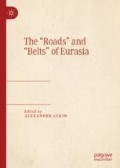Abstract
Asia remains one of the world’s fastest-growing regions economically, but also one with the greatest lack of international regulation. While the other poles of global economic development, primarily Europe and North America, include comprehensive and high-quality free trade zones—and multi-level integration structures in the case of the former—the international institutional environment in Asia remains underdeveloped.
The research for this chapter was supported by a grant from the Faculty of World Economy and International Affairs of the National Research University—Higher School of Economics.
Access this chapter
Tax calculation will be finalised at checkout
Purchases are for personal use only
Notes
- 1.
H. Kissinger, World Order, (Penguin Press, 2015). pp. 1–2.
- 2.
See: P. Deutcher and C. Lafont, Critical Theory in Critical Times: Transforming the Global Political and Economic Order (New Directions in Critical Theory), (Columbia University Press, 2017); H. Kissinger, World Order, (Penguin Press, 2015); B. Lo, Russia and the New World Disorder, (Brookings Institute Press, 2015).
- 3.
J. Nye, International Regionalism; Readings, (Little, Brown and Company, 1968).
- 4.
B. Buzan and O. Woever, Regions and Powers. Structure of International Security, (Cambridge University Press, 2003).
- 5.
P. Katzenstein, “Area Studies, Regional Studies, and International Relations”, Journal of East Asian Studies, February 2002, 2(1).
- 6.
J. Nye, International Regionalism; Readings, (Little, Brown and Company, 1968), p. 7.
- 7.
G. Capanelli, “Institutions for Economic and Financial Integration in Asia: Trends and Prospects”, ADBI Working Paper Series, No. 308, 2011.
- 8.
T. Bordachev, C. Xin, and A. Likhaeva, “What Asia Wants”, Russia in Global Policy, 2015, http://www.globalaffairs.ru/number/Chego-khochet-Aziya-17310 (Accessed December 20, 2016).
- 9.
A. Sidorov, “APEC in Search of a New Development Paradigm”, Moscow University Bulletin, Series 25, International Relations and World Politics, no. 2, 2009.
- 10.
A. Capling and J. Ravenhill, “Multilateralising Regionalism: What Role for the Trans-Pacific Partnership Agreement?”, The Pacific Review, 2011, 24(5).
- 11.
B.R. Williams (ed.), “The Trans-Pacific Partnership: Strategic Implications”, Congressional Research Service Report, February 3, 2016, https://www.fas.org/sgp/crs/row/R44361.pdf.
- 12.
Agreement on TPP. Chapter 18, United States Trade Representative Office, https://medium.com/the-trans-pacific-partnership/intellectual-property-3479efdc7adf#.fy725nd0a.
- 13.
A. Bishop, “Standard Power: The New Geopolitical Battle”, National Interest, October 7, 2015, http://nationalinterest.org/feature/standard-power-the-new-geopolitical-battle-14017.
- 14.
E. Devadason, “The Trans-Pacific Partnership (TPP): The Chinese Perspective”, Journal of Contemporary China, 2012, 23(87), pp. 462–479.
- 15.
C. Richards, “The US and China’s Competing FTA’s During APEC”, The Diplomat, November 7, 2014.
- 16.
M. Froman, “Remarks on Strategic Importance of Trans-Pacific Partnership”, Council on Foreign Policy, September 18, 2014, http://www.cfr.org/trade/remarks-ambassador-froman-strategic-importance-trans-pacific-partnership/p33473.
- 17.
L. Drutman, “How Big Pharma (and Others) Began Lobbying on the Trans-Pacific Partnership before You ever Heard of It”, Sunlight Foundation, 2014, http://sunlightfoundation.com/blog/2014/03/13/tpp-lobby/.
- 18.
Broadbert et al., “Trans-Pacific Partnership Agreement: Likely Impact on the US Economy and Specific Industry Sectors”, United States International Trade Commission Report, 2016.
- 19.
“Trans-Pacific Partnership”, Office of the United States Trade Representative, https://ustr.gov/tpp.
- 20.
“Trade Overview”, International Trade Administration, http://www.trade.gov/mas/ian/build/groups/public/@tg_ian/documents/webcontent/tg_ian_002065.pdf.
- 21.
Broadbert et al., “Trans-Pacific Partnership Agreement: Likely Impact on the US Economy and Specific Industry Sectors”, United States International Trade Commission Report, 2016, p. 76.
- 22.
M. Solis, “The Case for the Trans-Pacific Partnership”, Brooking Institute, 2016, https://www.brookings.edu/research/the-trans-pacific-partnership-the-politics-of-openness-and-leadership-in-the-asia-pacific/.
- 23.
A. Stamoulis, “Trading Away the Future: An Analysis of the Trans-Pacific Partnership”, New Labor Forum, 2014, 22(3), pp. 30–37.
- 24.
J. Stiglitz, “Why TPP is a Bad Deal for America and American Workers”, Roosevelt Institute, March 28, 2016, http://rooseveltinstitute.org/why-tpp-bad-deal-america-and-american-workers/.
- 25.
J. Cabaldo and A. Izurieta, “Trading Down: Unemployment, Inequality and Other Risks of the Trans-Pacific Agreement”, Global Development and Environment Institute, Working Paper No 16-01, 2016.
- 26.
Broadbert et al., “Trans-Pacific Partnership Agreement: Likely Impact on the US Economy and Specific Industry Sectors”, United States International Trade Commission Report, 2016.
- 27.
Report on Potential Macroeconomic Implications of the Trans-Pacific Partnership, World Bank Global Economic Prospects, 2016.
- 28.
D. Rosnik, “Gains from Trade? The Net Effect of the Trans-Pacific Partnership on Agreement on US Wages”, Center for Economic Policy Research [Web Portal], 2013, http://www.cepr.net/documents/publications/TPP-2013-09.pdf.
- 29.
B. Obama, “Remarks by President Obama in Sanctuary Hall”, White House, November 14, 2009, https://www.whitehouse.gov/the-press-office/remarks-president-barack-obama-suntory-hall.
- 30.
B. Gordon, “The Trans-Pacific Partnership and the Rise of China”, Foreign Affairs, November 7, 2011.
- 31.
G. Chang, “TPP vs. RCEP: America and China Battle for Control of Pacific Trade”, The National Interest, October 6, 2015.
- 32.
“Statement of the Trans-Pacific Partnership Leaders”, White House, November 10, 2014, https://www.whitehouse.gov/the-press-office/2014/11/10/trans-pacific-partnership-leaders-statement.
- 33.
S. Tiezzi, “As TPP Leaders Celebrate, China Urges Creation of Asia-Pacific Free Trade Area”, The Diplomat, November 19, 2015.
- 34.
B. Davis, “China, US Parry Over Preferred Trade Pacts at APEC”, The Wall Street Journal, November 9, 2014.
- 35.
Foreign Aid Statistics by Country, Foreign Assistance Statistical Webpage, http://beta.foreignassistance.gov/.
- 36.
TASS, “Putin Called for a Big Eurasian Partnership”, Petersburg International Economic Forum 2016, 2016, http://tass.ru/pmef-2016/article/3376295 (Accessed February 2, 2018).
- 37.
“President of Russia”, Meeting with President of China Xi Jinping, 2017, http://en.kremlin.ru/events/president/news/54733.
Author information
Authors and Affiliations
Corresponding author
Editor information
Editors and Affiliations
Rights and permissions
Copyright information
© 2020 The Author(s)
About this chapter
Cite this chapter
Novikov, D. (2020). From Asia-Pacific to Greater Eurasia: Regional Projects of Economic Orders and Great Power Competition. In: Lukin, A. (eds) The “Roads” and “Belts” of Eurasia. Palgrave Macmillan, Singapore. https://doi.org/10.1007/978-981-15-0856-1_14
Download citation
DOI: https://doi.org/10.1007/978-981-15-0856-1_14
Published:
Publisher Name: Palgrave Macmillan, Singapore
Print ISBN: 978-981-15-0855-4
Online ISBN: 978-981-15-0856-1
eBook Packages: Political Science and International StudiesPolitical Science and International Studies (R0)

